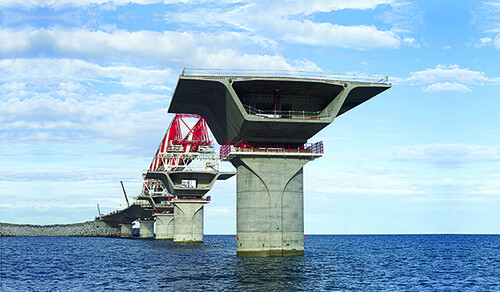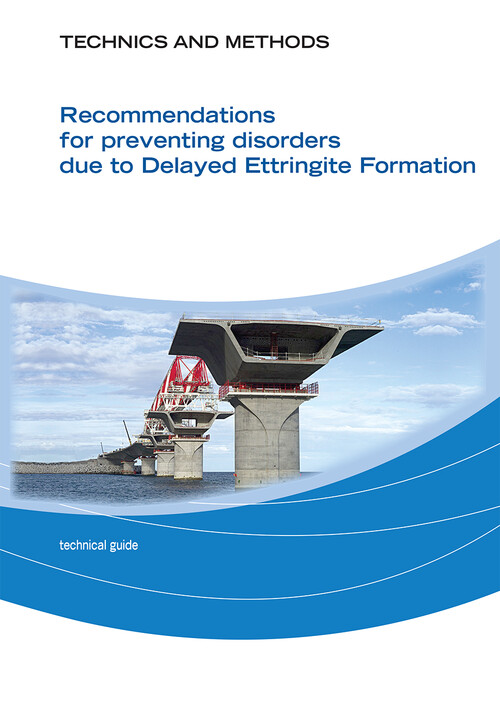Recommendations for preventing disorders due to delayed ettringite formation
The delayed ettringite formation causes an expansion and a cracking of concrete. Concrete durability experts are familiar with the phenomenon, the conditions under which it occurs and how to prevent it for future structures.

Photo credit: Sébastien Marchal, Viaduc Littoral photo library
The book in a few words
Delayed Ettringite Formation (DEF) is a cause of disorders that can cause quite severe damage in concrete structures, by expansion of concrete, then cracking of the structures. This reaction occurs in particular because of a significant heating of the concrete intervened several hours or several days after its casting. It concerns civil engineering structures and buildings comprising elements of important size that are in contact with water or subjected to a wet environment.
While only a few cases have been reported in France, they are still significant enough to justify taking certain precautions for new construction. According to our current state of knowledge, only a few research results have actually been published on the treatment of structures affected by delayed ettringite formation and moreover no treatment solution has been proposed to halt the progression of this reaction within structures. Given this situation, a preventive approach proves essential in seeking to avoid the occurrence and development of this phenomenon in structures to be built.
The Recommendations for preventing disorders due to delayed ettringite formation are for structure owners, contractors and civil engineering companies in order to assist them in setting the level of prevention to be achieved by the structure and the provisions to be taken relating to the design and dimensioning of structure and to the composition, manufacture and pouring of concrete.
The present recommendations are an update of the previous 2007 recommendations they are replacing, taking into account new knowledge gained since the previous publication.
To know more about the book
- Bruno GODART (Ifsttar)
- Loïc DIVET (Ifsttar)
- AMMOUCHE Abdelkrim, Lerm
- BEAUFORT Yohan, Vicat
- BENBOUDJEMA Farid, ENS Cachan
- BESSETTE Laetitia, Vicat
- CASABIEL Ludovic, CIMbéton
- CUSSIGH François, VINCI Construction France
- DELORT Michel, ATILH
- DIVET Loïc, Ifsttar
- ESCADEILLAS Gilles, INSA Toulouse
- FOURMENT Yvon, CEMEX
- GODART Bruno, Ifsttar
- GONNON Pascal, Omya
- GOTTELAND Philippe, FNTP
- GUILLOT Xavier, Lafarge France
- HASNI Lotfi, Ginger-CEBTP
- IZORET Laurent, ATILH
- JEAN-PIERRE Alain, EDF
- LAVAUD Stéphane, Ifsttar
- LEKLOU Nordine, Université de Nantes
- LINGER Lionel, VINCI Construction grands projets
- MARTIN Renaud-Pierre, Ifsttar
- PETITPAIN Marjorie, Cerib
- POTIER Jean-Marc, SNBPE
- RIZZO Nicola, ECOCEM France
- ROUGEAU Patrick, Cerib SAUVAGET Cyril, EDF
- TORRENTI Jean-Michel, Ifsttar
- WALLER Vincent, Unibéton / HeidelbergCement Group
The aim of the present recommendations is to limit the risk of disorders occurring due to an internal sulphate reaction. The latter is caused by the delayed formation of ettringite in a cementitious material and occurs in particular because of a significant heating of the concrete intervened several hours or several days after its casting. It causes an expansion of concretew hich in turn generates a cracking of the structures. This reaction can be encountered with two types of concrete: heat-treated concretes and concretes cast in place in so-called critical elements.
These recommendations are concerned with civil engineering structures and buildings comprising elements of important size that are in contact with water or subjected to a wet environment. They set the level of prevention to be achieved according to the category of the structure (or to the part of the structure) and to the exposure conditions. For each of the four levels of prevention selected, associated precautions are applied and associated checks are carried out. They also contain provisions relating to the design and dimensioning of structures, the composition and manufacture of concrete, and its pouring.
The present recommendations combine a performance approach and specifications of means, and are an update of the previous 2007 recommendations they are replacing, taking into account new knowledge gained since.
- Introduction
- Chapter 1. General remarks on Delayed Ettringite Formation
- 1.1 Delayed Ettringite Formation Phenomenon
- 1.2 The main parameters associated with Delayed Ettringite Formation
- 1.3 The current standardization context
- 1.4 Influence of concrete constituents and composition
- Chapter 2. Determination of the required level of prevention
- 2.1 Category of the given structure or structural part
- 2.2 DEF exposure classes
- 2.3 Levels of prevention
- Chapter 3. Precautions adopted based on level of prevention
- 3.1 Level of prevention: As
- 3.2 Level of prevention: Bs
- 3.3 Level of prevention: Cs
- 3.4 Level of prevention: Ds
- 3.5 Some comments on combinations of cement and mineral additions
- Chapter 4. Provisions related to design and calculation of structures, concrete mix design and fabrication, as well as placement
- 4.1 General remarks
- 4.2 Provisions related to the design and calculation of structures
- 4.3 Provisions related to concrete mix design
- 4.4 Provisions related to concrete fabrication and transport
- 4.5 Provisions related to concrete placement
- 4.6 Specific provisions for pre-casting
- Appendix 1 Some precisions on Delayed Ettringite Formation
- Appendix 2 Review of the exothermic nature of concrete
- Appendix 3 Estimation of temperatures reached in planned structures
- Appendix 4 Performance-based testing
- Appendix 5 Approval methodology for CEM I SR3 and SR5 conforming to the marking NF – Liants hydrauliques (NF002)
- References
Ifsttar. Recommendations for preventing disorders due to Delayed Ettringite Formation. Marne-la-Vallée: Ifsttar, 2018. Technics and methods, GTI5-A, 70 pages. ISBN 978-2-85782-745-0
- English version, pdf file (ISBN 978-2-85782-745-0), free download licenced under CC BY-NC-ND 4.0.
- French version, pdf file (ISBN 978-2-85782-738-2), free download licenced under CC BY-NC-ND 4.0.
- French version, paperback (ISBN 978-2-85782-737-5), for sale 30 € excl. tax, contac us
Identity card of the book
| Title: | Recommendations for preventing disorders due to Delayed Ettringite Formation |
| Author: | Ifsttar |
| Publisher: | IFSTTAR |
| Collection: | The IFSTTAR's collections |
| Reference: | GTI5-A |
| ISBN: | 978-2-85782-745-0 |
| Edition: | Pdf file, free download |
| License: | CC BY-NC-ND 4.0 |
| Publication date: | Published in october 2018 |
| Number of pages: | 70 pages |
| Language: | English (French version available) |
| Key words: | concrete, internal sulphate reaction, delayed ettringite, prevention, precaution, temperature, heating, design, composition, placing |
| Contact: | librairie(at)univ-eiffel.fr |

![[Translate to English:] Licence creative commons BY-SA 4.0 [Translate to English:] Licence creative commons BY-SA 4.0](https://reflexscience.univ-gustave-eiffel.fr/fileadmin/ReflexScience/Accueil/Logos/CCbySA.png)